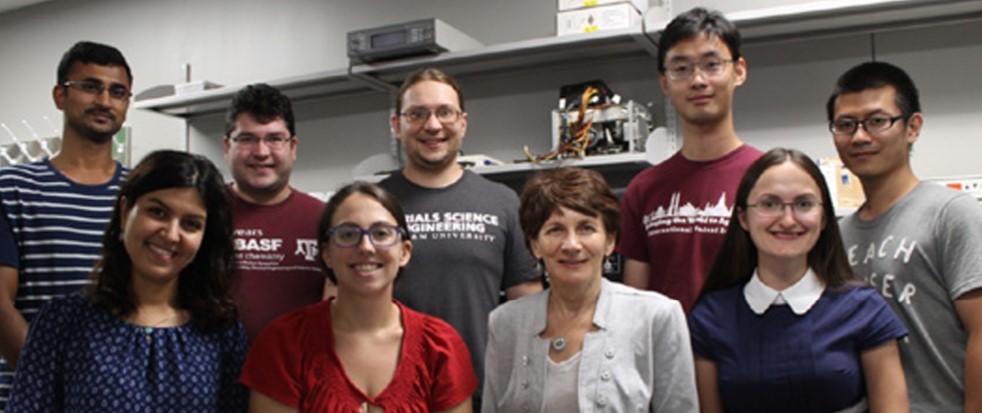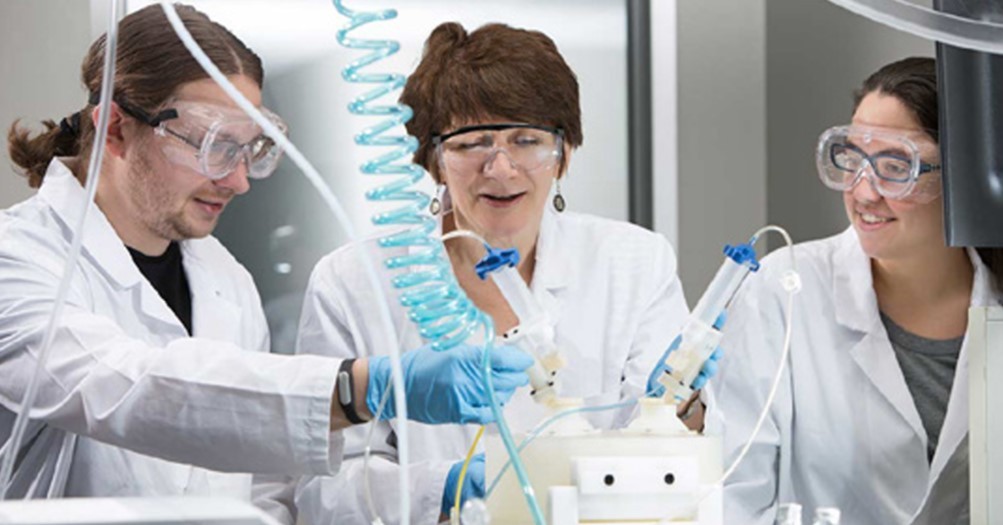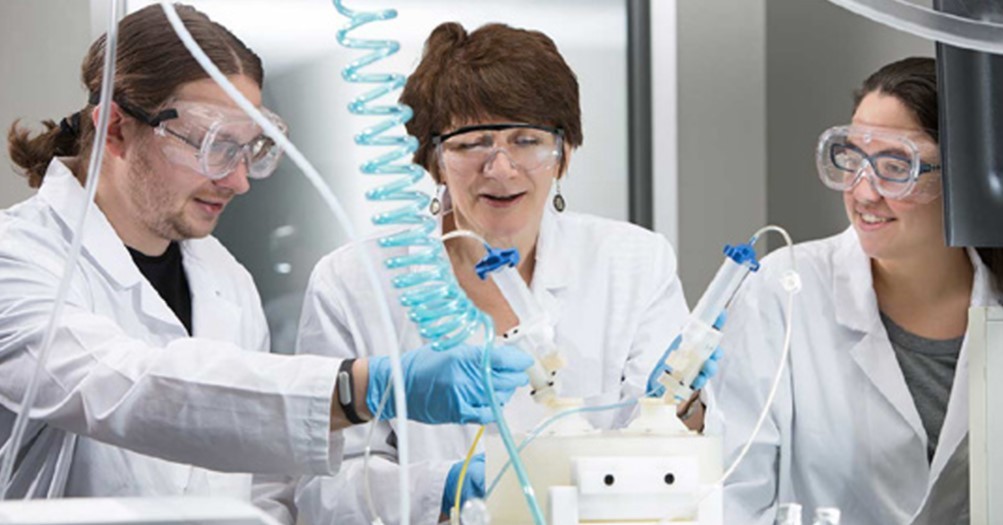Smart on-demand Self Defensive Coatings of Biomedical Devices - How Self Activating Anti Biotics Work
- 11 Oct 2017
- Volume 11
- NanoScientific Magazine, Fall 2017

Prof. Sukhishvili is the recipient of numerous awards including Provost’s Entrepreneurship Award, NSF Special Creativity Award, Davis Award for Research Excellence, Award for Distinguished Scientific Achievement American Coatings Association and is a member of the Editorial Advisory Board for Particle & Particle Systems Characterization and is a frequent guest presenter at American Chemical Society and American Physical Society and other industry events.

Pictured: Prof. Svetlana A. Sukhishvili (front row) with her research group at the Department of Materials Science and Engineering Texas A&M University where their research focuses on many areas of polymer science including stimuli-responsive allpolymer and polymer nanocomposite assemblies for sensing, separation and biomedical applications
What are smart self-defensive antibiotic coatings and how were they discovered?
The practical problem we address is bacterial infection associated with biomaterials, such as orthopedic implants or urinal devices, for example. The traditional treatment of biomaterial-associated infections with systemic antibiotics is often inefficient because of the formation of bacterial biofilms in which bacteria are poorly responsive to treatment. Polymer coatings have been earlier explored to prevent surfaces from colonization with bacteria, but in most cases these coatings continuously elute antibiotics, increasing emergence of antibiotic resistance.
Our focus is on another approach, which minimizes the emergence of antibacterial resistance. We are using smart coatings, which contain antibiotic, but do not elute it until they get activated by stimuli. Prior work explored such on-demand activation of polymer coatings when various external stimuli, such as pH, temperature or light are used. In contrast, our group explores a different type of the coatings -“self-defensive” coatings – which are triggered by bacteria rather than external stimuli. Specifically, we are using acids excreted by bacteria as triggers for antimicrobial release from the coating to combat adhering bacterial. By applying confocal imaging techniques, we have demonstrated that bacterial acidification can be highly localized even in buffered physiological conditions, and that this highly localized bacterial signals can be used to release antimicrobial cargo from the films and kill adhering bacteria.
How do layer-by-layer films enable the self activation process?
We work with ultra-thin layer-by-layer films, which are built when molecules of at least two types are layered at surfaces in a simple dip-, spray- or spin, aqueous-based deposition. The molecules are held together in the coating by through electrostatic pairing or and hydrogen bonding interactions. One type of these molecules can be an antibacterial compound. When these films are assembled, electrostatic interactions are balanced and the film interior is overall electrostatically neutral. Such coatings are stable and do not release antimicrobials at a constant pH, i.e. in absence of bacteria. When a signal – i.e. bacteria-induced acidification – if ‘felt’ by the coatings, the balance of charges shifts and the coating releases antibiotic to compensate for the bacteria-induced charge misbalance.
What is the Role of 3D Hierarchical Nanostructures for this process?
Building hierarchical nanostructures at solid surfaces (such as on titanium, often used as an implant material) boosts the efficiency of the self-defensive coatings. Here, an antibacterial layer-by-layer (LbL) film and hierarchical nanotopography act synergistically to efficiently antibiotics and kill bacteria. This occurs in a couple of different ways: (a) first, the overall increase in the surface area leads to a greater exposure of bacteria to antibiotic coatings; (b) when bacteria land on the 3D-nanopillared structures, bacterial adhesion is reduced and their susceptibility to antibiotics is increased.
How is Atomic Force Microscope used in your research and why is it helpful?
AFM is a working horse in our explorations of smart coatings. One type of these coatings contains assembled block copolymer micelles, whose cores controllably swell /deswell in response to changes in environmental pH or temperature. In this case, we find AFM that is performed in liquid environment (in water) to be indispensable to directly observe expansion and contraction of LbL-assembled spherical micelles in response to various stimuli.
How do you collaborate with The Spallation Neutron Source at ORNL? Is this type of collaboration with other researchers important and beneficial to your work?
To study the functionality of our smart layerby-layer coatings, we need to understand their internal structure and dynamics of assembled molecules. To that end, graduate students in our group closely collaborate with John Ankner from SNS ORNL to design and perform experiments that enable such an understanding. We create nanoscopically structured films at the surface of silicon substrates, while assembling some deuterated components in order to be able to detect film structure using neutron reflectometry (NR). Students from my group then travel to ORNL to perform NR experiments. The collaboration has been extremely productive, resulting in almost a dozen joint publications with SNS ORNL within the last 10 years. We hold weekly conference calls with John Ankner to discuss prior results and plan new experiments. These interactions are mutually beneficial and enjoyable. Graduate students greatly enrich their experiences by working with the national lab experts, while through both personal interactions and through participation in the SNS Users Workshops we have a unique opportunity to provide feed back on instrumental development at ORNL and interact with ORNL computational/modelling community.
What nanotechnology advances do you see in the future for biomedical devices?
While many of the technologies we are working on still wait to make their way to the market, I envision that the work of the highly inventive scientists in the area of smart coatings will eventually make a tremendous impact on the future of biomedical devices. The coatings, which are nanoscopically thin, and/or are deposited on nanostructured substrates can be designed to be extremely effective against bacterial adhesion and biofilm formation. The ‘lack’ in their thickness can be compensated by the smart design that assures targeted, ondemand ‘activation’ to deliver antimicrobials. In the future such innovative design will assure that the coatings will be available to completely eliminate chances of infection of biomedical devices, while the side effects and the development of antibiotic resistance associated with the use of these devices will be minimized.

Prof. Sukhishvili is a Member of the Executive Committee of the new Soft Matter Research User Facility at the Department of Materials Science & Engineering at Texas A&M
“WE FIND AFM THAT IS PERFORMED IN LIQUID ENVIRONMENT (IN WATER) TO BE INDISPENSABLE TO DIRECTLY OBSERVE EXPANSION AND CONTRACTION OF LBLASSEMBLED SPHERICAL MICELLES IN RESPONSE TO VARIOUS STIMULI.”
The facility will help users conduct research to improve multifunctional polymerbased materials that are used in many applications, including energy, health care and transportation, among others, and will benefit the entire Texas A&M research community. The project includes 29 faculty members across multiple colleges and centers, including the colleges of engineering, science, and agriculture and life sciences at Texas A&M, in addition to the Texas A&M Health Science Center, representing all entities across the university actively involved in soft materials-related research and is the only user facility in Texas specifically dedicated to the characterization of multifunctional soft materials. Sukhishvili and the members of the executive committee are hopeful that collaborative efforts in this facility will enable new discoveries in health care, soft robotics, biomanufacturing and environmental protection by acting as a nucleus of activity for collaborative research efforts not only at Texas A&M, but ideally across the state and nation. The soft matter facility is funded through the Research Development Fund for about $1.7
